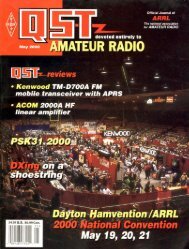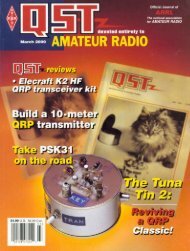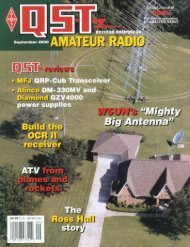September/October 2000 NCJ
September/October 2000 NCJ
September/October 2000 NCJ
Create successful ePaper yourself
Turn your PDF publications into a flip-book with our unique Google optimized e-Paper software.
PropagationCarl Luetzelschwab, K9LAk9la@gte.netThe Importance of 40 Meters in DX ContestsIn November of1994, I had thepleasure of joiningJoe, W6VNR/ZF2AH; Bruce,W6OSP/ZF2QM;and Bob, K4UVT/ZF2RF, in a multisingleeffort asZF1A for theCQWW CW Contest.We ended upwith a decentscore—nothingspectacular, K9LAthough. But thatwas okay, wewent there mainly to have some fun. Ourgoal was to have a good time and handout the ZF multiplier—not to win the World.A couple years later I started thinkingabout what it would take to do significantlybetter in the multi-single category.One of my thoughts was “for a seriouseffort, what band should we start thecontest on and remain on throughoutthe night?”For our 1994 ZF1A effort, we startedthe run station on 20 meters and stayedthere for about 6 hours, working USstations at a good clip. There were quitea few JA stations and a handful of EUstations in there, too, but the log datarevealed that 72% of our Qs for the first6 hours of the contest were with 2-pointNorth American stations. Due to theQSO point structure for the CQWW contestsfrom the Caribbean, that’s okay forfun and the thrill of high rates, but thismay not be a good strategy for a seriouscontest effort.To maximize your score, you want tobe on the band at the start of the contestand throughout both nighttime periods,0000 to 1000Z, that offers the bestchance of working 3-point stations.After looking over the breakdownsheets for the J6DX World multi-singlewinning efforts in the CQWW CW contestsfor 1993 and 1996, it wasn’t hard tofigure out that 20 meters isn’t where weshould have been operating during thenighttime hours. Thanks to Scott, N9AG(J6DX team member and snappydresser), for sharing the J6DX data.Table 1 shows the approximate numberof hours spent on each of the bandsby ZF1A in ’94, J6DX in ’93, and J6DX in’96 during the two 10-hour periods between0000 and 1000Z—the dreaded,but extremely important, night shifts (20hours total).The numbers show that the winningefforts spend most of the night on 40meters, with short excursions to 80 metersand even shorter excursions to 160meters—mostly to pick up multipliers.Next I used MINIPROP PLUS 2.5 totry to understand why 40 meters is favoredover 20 meters. Figure 1 givesthe results of that effort. This is a plot ofthe MUF (maximum usable frequency)from ZF to Europe and Japan (both 3point QSOs) and to North America (2point QSOs) for 0000 to 1000Z for anSSN (smoothed sunspot number) of 26for November 1994.Since our model of the ionosphere forpropagation predictions is a correlationbetween the SSN and monthly medianionospheric parameters, the MUF fromour propagation software is also a medianvalue. This means that the actualMUF will be below the predicted MUF onhalf of the days of the month, and abovethe predicted MUF on the other half ofthe days of the month (remember lastissue’s column?). If we only knew whichdays were going to be above and whichwere going to be below… (More on thissubject in another column.)Figure 1 reveals the problem with 20meters. Since the predicted MUFs arebelow 14 MHz except for the first hour toJapan, these openings on 20 meters willoccur on significantly less than half ofthe days of the month. In other words,whether or not 20 meters opens is at thewhim of the day-to-day variability of theionosphere.On the other hand, 40 meters is farenough below the predicted MUF to essentiallybe a sure thing to Europe andJapan. Applying sunrise and sunsettimes says 40 meters should be excellentto Europe from ZF sunset—around2300Z, until European sunrise—around0700Z, and it should be excellent toJapan from their sunset—around 0800Z,until ZF sunrise—around 1200Z.Since all of the above operations wereundertaken during periods of relativelylow SSN (the smoothed sunspot numberfor the 1993 J6DX effort was thehighest—41), a good question to ask is“what will be the effect of a higher SSN?”Some more work with MINIPROPPLUS 2.5 shows that, as expected, theMUF gets higher as the SSN increases.It very well could be that 20 meters couldchallenge 40 meters near solar maximumfor “best nighttime band” honors.I took a look at this using the 6Y2A logdata from their November 1998 CQWWCW multi-multi effort, when Cycle 23was at an SSN of 73. Thanks to Dean,N6BV (6Y2A team member and a real6-lander again), for supplying that information.Since 6Y2A was a multi-multi effort,they didn’t have to make a decisionbetween 20 meters and 40 meters—they were going hot and heavy on bothbands simultaneously. This allows us tolook at the contribution from each bandby computing each band’s individualscore (QSO points times multipliers).For the two contest periods of 0000 to1000Z, 20 meters yielded 652 2-point-Figure 1—A plot, generated by MINIPROP PLUS 2.5, of the maximum usablefrequency between 0000 and 1000Z from ZF to Europe, Japan and NorthAmerica for November 1994 (smoothed sunspot number=26).35
















